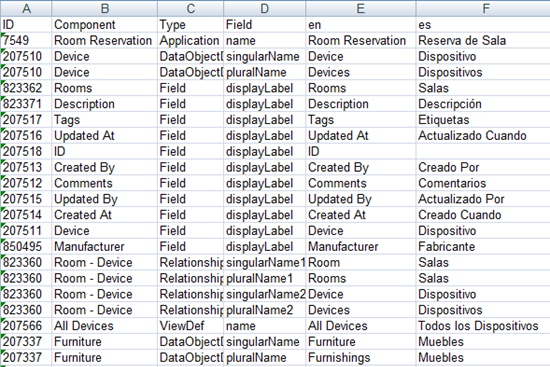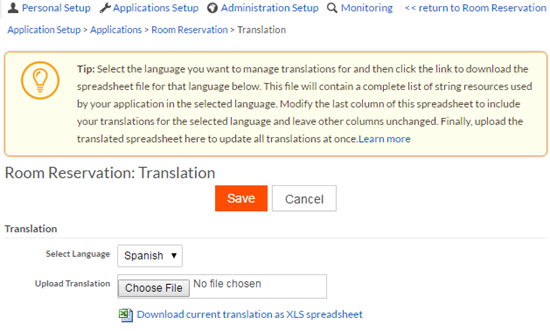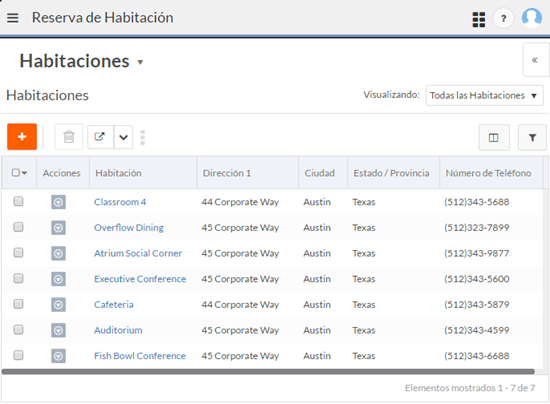Translating applications
You can translate an application if one or more additional languages are assigned in the tenant's Account Settings. Translations are limited to languages available in the account settings. To translate an application, you need to translate its component names and labels, such as the application name, object names, and field labels, as well as the application data input by users. See Translating application data for more information about translating application data. In addition, you can create multilingual string tokens to use in templates and formulas. This allows any text displayed by the code to appear in the current user's language. See Creating and using multilingual string tokens for more information.
There are two methods for translating application component names and labels:
- Translating them individually on setup pages. Infinite Blue recommends using this method when you are updating an existing, translated application by adding objects, fields, views, or other components. You can also use this method when creating a new application from scratch, adding translations as you create components. See Translating individual components for examples. See Translating application component names and labels for a complete list of what you can translate for each component type and where to translate each.
- Translating all application component names and labels by uploading a spreadsheet containing the translations. Infinite Blue recommends using this method to update an existing application that has not been translated. This is a good method to use when a third party, such as a translation company, will be providing the translation. You can also use this method when adding objects to an existing translated application, to translate the components automatically created during object creation. See Translating component names and labels using a spreadsheet for details.
Translating individual components
Enter translations for component names and labels when creating or editing them. For example, the following screen shows translations for a field label.

Translate page names, page tab titles, and section titles on the Page Properties screen. Access the Page Properties screen from the Pages section of an object definition screen. For example, the following screen shows translations for a page name.

Note that Platform renders languages that are written from right to left, such as Arabic in the above screens, automatically from right to left.
To translate values for picklists, multi-select picklists, radio buttons, and groups of check boxes, you must first save them in the base language and edit them to specify the field values for additional language fields. See Picklist, radio button, and group of checkboxes fields for an example.
Translating component names and labels using a spreadsheet
You can translate all component names and labels for an entire application in one spreadsheet. A single spreadsheet can contain translations for one language. The main steps include downloading a spreadsheet that lists component names and labels with built-in translations, adding translations to the spreadsheet, and uploading the fully translated spreadsheet.
The downloaded file contains the Platform translations for that language and has the following format:
| Column | Content |
|---|---|
| A | Original ID of item |
| B | Component's name |
| C | Component's type |
| D | Field's name (inside component) |
| E | Text in base language |
| F | Text in foreign language |
Do not modify content of the first five columns as that can render the spreadsheet useless. Only change translations in the column F using text in column E as a reference. The following screen shows a portion of a translation spreadsheet with a base language of English and a translation in Spanish:

Follow these steps to translate an application using a spreadsheet:
- Navigate to the application's Setup Application screen. (See Editing applications).
- From the More Actions menu, click Translation. The Translation screen
opens.

- Select one of the available languages and click Download the current translation as XLS spreadsheet.
- Update the spreadsheet as described above, adding translations to column F.
- Save the XLS file to your local disk.
- Navigate to the Translation screen, verify that the correct language is selected, and upload the XLS file. Platform reads the file once to translate application components and keeps the file as an application resource.
- If you later modify the translations in the XLS file, follow steps 4 through 6 using the updated file. You can then re-publish the application or serialize it to XML.
The following screen shows an application that has been translated to Spanish. Note that existing application data has not yet been translated in this example. See Translating application data for information about translating data.


